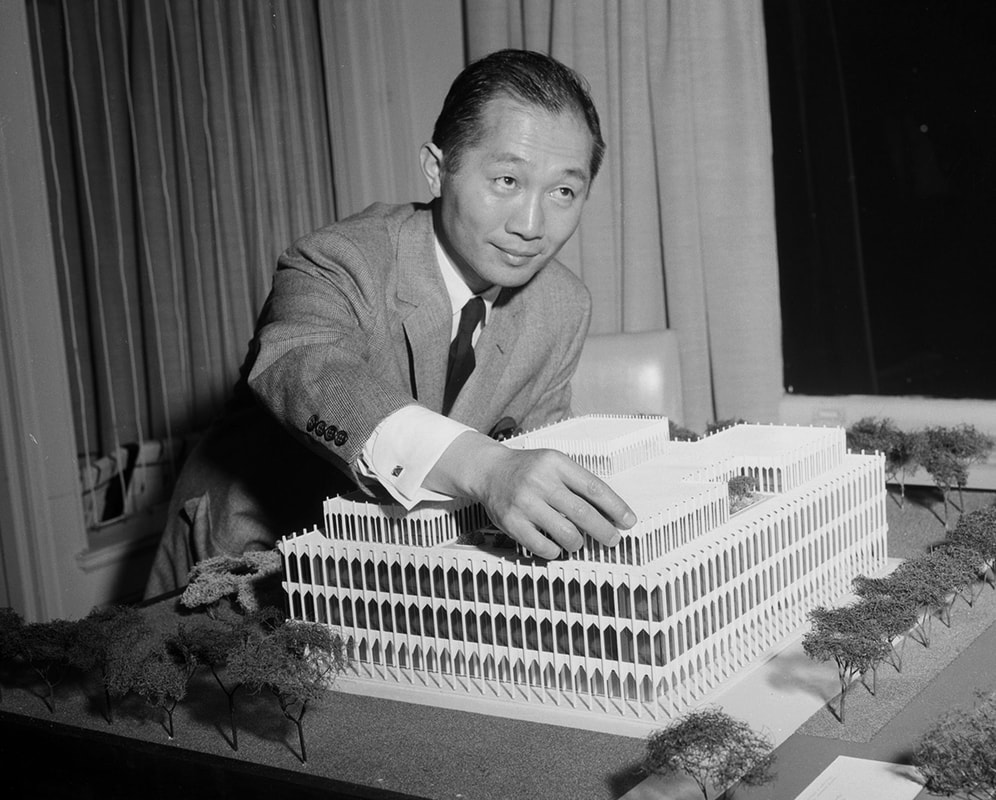Minoru Yamasaki in Minnesota
Minoru Yamasaki with Model, 1958. Image Credit: Walter P. Reuther Library, Archives of Labor and Urban Affairs, Wayne State University
Minoru Yamasaki in Minnesota
Tracing Minoru Yamasaki’s career trajectory through his Modernist designs in Minnesota. Adapted from Yamasaki in Minnesota Tour, prepared by Mary Begley (September, 2020).
Tracing Minoru Yamasaki’s career trajectory through his Modernist designs in Minnesota. Adapted from Yamasaki in Minnesota Tour, prepared by Mary Begley (September, 2020).
|
MINNESOTA 1958-1981
Minoru Yamasaki designed 8 buildings in Minnesota between 1958 and 1981. These years span the most productive and successful period of Yamasaki’s work, bookended by the construction of Pruitt Igoe in 1954 and the opening of the World Trade Center in 1973. |
|
EARLY BEGINNINGS
Yamasaki was born in Seattle, WA in 1913, a member of the Nisei generation of Americans, born to parents who immigrated from Japan. Yamasaki’s family and other Japanese-American families in the United States prior to at the time of the attack on Pearl Harbor were subject to extreme racism, in particular on the West Coast. The period of internment of Japanese-Americans lasted from 1942-1945, when racist and xenophobic legislation caused the imprisonment and forced relocation of 120,000 people of Japanese descent in the United States.
Yamasaki attended NYU, and worked for Shreve, Lamb & Harmon after graduating in 1934. Yamasaki relocated to Michigan in 1945 to work for Smith, Hinchman & Grylls. In 1949, Yamasaki formed a new practice: Leinweber, Yamasaki & Hellmuth.
Yamasaki was born in Seattle, WA in 1913, a member of the Nisei generation of Americans, born to parents who immigrated from Japan. Yamasaki’s family and other Japanese-American families in the United States prior to at the time of the attack on Pearl Harbor were subject to extreme racism, in particular on the West Coast. The period of internment of Japanese-Americans lasted from 1942-1945, when racist and xenophobic legislation caused the imprisonment and forced relocation of 120,000 people of Japanese descent in the United States.
Yamasaki attended NYU, and worked for Shreve, Lamb & Harmon after graduating in 1934. Yamasaki relocated to Michigan in 1945 to work for Smith, Hinchman & Grylls. In 1949, Yamasaki formed a new practice: Leinweber, Yamasaki & Hellmuth.
- For more on the life of Minoru Yamasaki, see: Gyure, Dale Allen. Minoru Yamasaki: Humanist Architecture for a Modernist World. New Haven: Yale University Press, 2017.
- For more on the Japanese American experience in this period, see: Ed. Noumura, Gail M., and Louis Fiset. Nikkei in the Pacific Northwest: Japanese Americans & Japanese Canadians in the 20th Century. Seattle: University of Washington Press, 2005.
|
PRUITT-IGOE OPENS 1954-1972
In 1954, Pruitt-Igoe, a public housing complex in St. Louis, opened. The grouping of monumental buildings reflected modernist design ideals, akin to Le Corbusier’s Villa Radieuse. The constructed buildings were vastly altered from Yamasaki’s original plans; early sketches of the design show human-scaled buildings, lively with greenery and families. The 1949 Federal Housing Act provided limited funds for the project, heavy with racist and classist conditions. The project ultimately failed amidst widespread criticism of all complicit systems, including architecture.In 1954, however, the project was the largest yet commission for Yamasaki.
|
|
|
ST. LOUIS LAMBERT INTERNATIONAL AIRPORT 1955
As the decade went on, Yamasaki’s acclaim spread. The Lambert-St. Louis International Airport opened in 1955. Also in this year, Yamasaki received commission for American Consulate in Kobe, Japan, and spent time traveling in Japan, the Middle East, and Europe. The influence of Asian and Gothic architecture on his work is a noteworthy throughline, important to understand Yamasaki’s relationship to history. |
|
|
McGREGOR MEMORIAL CONFERENCE CENTER 1958
McGregor Memorial Conference Center at Wayne State University in Detroit opened in 1958. The influence of Japanese landscaping, seen on his trip East, is visible in this serene reflecting pool, use of shade and plants. |
|
|
PACIFIC SCIENCE CENTER 1962
1962 marks perhaps the apex of Yamasaki’s career. The Pacific Science Center and accompanying pavilion at Seattle World’s Fair opened to international visitors and positive reviews. The repeated motif of thin, pointed arches and wishbone-like columns, clad in white, show a fascination with Gothic and Islamic architectural elements. The incorporation of these forms into the structural systems and decorative elements simultaneously sets these designs apart as Yamasaki’s finest architectural works. |
|
WORLD TRADE CENTER COMMISSION 1962
Also in 1962, Yamasaki received the commission for the new World Trade Centers, to be built in Manhattan. This newsworthy, $270 million, 15-acre commission brought Yamasaki’s design ethic and body of work into critical discourse. In the New York Times, architecture critic Ada Louise Huxtable pinpointed the debate over Yamasaki’s designs, writing, “Materials are sumptuous; surfaces are intricate. These are exotic, elaborate designs intended to delight the senses. To many architects trained in the severe modern school, they represent nothing short of heresy.”
Also in 1962, Yamasaki received the commission for the new World Trade Centers, to be built in Manhattan. This newsworthy, $270 million, 15-acre commission brought Yamasaki’s design ethic and body of work into critical discourse. In the New York Times, architecture critic Ada Louise Huxtable pinpointed the debate over Yamasaki’s designs, writing, “Materials are sumptuous; surfaces are intricate. These are exotic, elaborate designs intended to delight the senses. To many architects trained in the severe modern school, they represent nothing short of heresy.”
|
CARLETON COLLEGE 1958-1966
In 1964 an exhibition titled “Carleton College Builds” opened at the Walker Art Center in Minneapolis. The exhibition displayed models, photographs, and drawings of Yamasaki’s designs for five buildings on the campus of Carleton College, located 40mi from the downtown Twin Cities in Northfield, MN. |
|
|
|
Olin Hall of Science 1961
The first of Yamasaki’s designs for Carleton was Olin Hall of Science, opened in 1961. A tiered screen of thin, white arches decorates the modern building, containing classrooms and laboratories. A large lecture hall is built into the hill, accessed through a graceful arcade. This design shows Yamasaki’s early incorporation of geometric patterns; these arches are applied to a simpler structural center. Compared to the pavilion at the Pacific Science Center, wherein similarly shaped arches are tessellated into complex parabolic structures, this design uses arches as decoration. |
|
|
Goodhue Hall 1962
In 1962 Goodhue Hall opened on the eastern edge of Carleton’s campus. Four utilitarian stories of dorm rooms are attached to a gracious common space, with Yamasaki’s signature geometric white facade treatment, overlooking the smaller of two lakes on Carleton’s campus. The dormitory building at Carleton is functional, utilitarian, almost like a hotel in its anonymity. Contrast this humble building with the extravagant grandeur of the Pacific Science Center, and note the year as the same when New York Port Authority chose Yamasaki over Philip Johnson and Walter Gropius for the World Trade Center commission. This year frames the breadth of Yamasaki’s work. |
|
|
West Gymnasium 1964
West Gymnasium opened in 1964, a new home for Carleton’s basketball and swimming teams, located near the Cannon River. A dramatic domed roof encloses basketball and swimming facilities; a strip of clerestory windows float the parabolic domes, made of poured concrete, above the facility walls. The design of West Gymnasium echoes and advances the uses of complex vaulting that Yamasaki first experimented with in the design of Lambert-St.Louis International Airport, in 1955. The 1964 opening of West Gymnasium included performances by the Minneapolis Symphony, performing on the basketball court, and the Dolphins, Carleton’s synchronized swimming team. A reporter from Sports Illustrated referred to the building as having a “potato chip roof.” The building’s use has been in decline since the opening of the new Recreation Center in 2000. In 2010, the West Gymnasium was flooded by the Cannon River. The building and its adjacent sports fields suffered extensive damage. |
|
|
Cowling Gymnasium, Watson Hall, Myers Hall 1958-1966
Cowling Recreation Center opened in 1965 and Watson Hall a year later. Both are understated rectangular buildings, with thin windows on each of the four sides. Watson Hall’s beveled corners and heavy roof overhang show influence of large scale sculptural forms associated with late Modernism and Brutalism. The sixth of Yamasaki’s designs for Carleton is an understated fourth-story addition to Myers Hall, a dormitory. Cowling, Watson, and Myers have a quiet craftsmanship to them. The use of humble materials is typical of higher-education architecture, yet the modern style reflects Carleton’s image as a progressive liberal arts school. |
|
NORTHWESTERN NATIONAL LIFE BUILDING 1965
In 1965, on a prominent plot in downtown Minneapolis, the Northwestern National Life (NWNL) Building opened. This graceful addition to downtown contains a portico at one end, the thin columns allowing a continuous visual line down Nicollet Mall to the Hennepin Avenue Bridge. The president of NWNL, John S. Pilsbury, was recommended to hire Yamasaki by members of the Dayton family. Through these prominent Twin Cities families, Yamasaki was hired in Minneapolis’ “first encounter with a starchitect.” The Gateway District, as the area surrounding NWNL Building was known, had previously been home to Minneapolis’ seediest downtown establishments, including liquor stores, brothels, and warehouses. These buildings, along with tenement housing, were demolished in the name of Urban Renewal. The placement of this monumental temple to modern capital marked a new beginning for Minneapolis’ downtown. Six stories and 220,000 square feet of office space are wrapped in a dignified colonnade, the white arches coming to points and flaring out at the cornice. Large panels of Vermont verde-antique marble are set into the void of the arch. Their book-leaf pattern creates an extravagant effect, amplified with knowledge that these panels are part of a structural wall system. The Minneapolis Tribune was not alone in their rave review of the building, writing that Yamasaki had fulfilled his “chief aim of architecture-to create serenity, surprise, and delight.” |
|
1962-1966
The high point of Yamasaki’s career, with the Pacific Science Center and World Trade Center commission in 1962, exhibition at the Walker in 1964, and the opening of Northwestern National Life Building in 1965, slowed dramatically as the decade came to an end. In 1966, Yamasaki revealed new plans for the World Trade Center buildings that were roundly criticized. Pruitt-Igoe was making headlines as the poster child of inner city blight, due to years of mismanagement and underfunding by the Housing Authority.
The high point of Yamasaki’s career, with the Pacific Science Center and World Trade Center commission in 1962, exhibition at the Walker in 1964, and the opening of Northwestern National Life Building in 1965, slowed dramatically as the decade came to an end. In 1966, Yamasaki revealed new plans for the World Trade Center buildings that were roundly criticized. Pruitt-Igoe was making headlines as the poster child of inner city blight, due to years of mismanagement and underfunding by the Housing Authority.
|
PRUITT-IGOE DEMOLISHED 1972
Architectural critic and theorist Charles Jencks is attributed with the idea that the “Death of Modern Architecture” occurred on July 15, 1972 at 3:32pm, in St. Louis Missouri as the first building at Pruitt-Igoe was demolished. His criticism is directed at the modernist notion that architecture can effectively create social change. Ada Louise Huxtable, writing in the New York Times was more sober yet no less damning in her critique of Pruitt-Igoe, writing, “...we have, with the best intentions, literally built in failure by erecting buildings that are actually designed to exacerbate crime and violence and problems of human behavior…” Pruitt-Igoe was the architectural manifestation of the Federal Housing Act, urban theories about Urban Renewal, and decades of racial tension in St. Louis (and the country at large). Despite a recent complication of this idea, Yamasaki’s career was harmed by criticism of the Pruitt-Igoe project as a dangerous, expensive, failure of architecture. |
|
|
WORLD TRADE CENTER OPENS 1973
In 1973, the World Trade Center opened. The Twin Towers, as they came to be known, used subtle white ribbing that ran the length of the building to great effect. The pointed arches, Islamic in form, at the base of the building formed continuous vertical lines that ran the length of the building, to a beveled corner that caused the edge of the skyscraper to vanish into the clouds. Reviews of the World Trade Center architecture were mixed at the time. The dramatic simplicity of the towers at a zoomed out scale made an impact on the skyline; it’s possible that the motifs applied by Yamasaki were less impactful than the buildings’ massive scale. The buildings became a symbol of American capitalism as the economy rocketed into the 1980s. The destruction of the Twin Towers in 2001 was shocking in its violence and symbolism. Again, Yamasaki’s designs were central in a paradigm shift of American culture - and again, Yamasaki’s designs were blown up on television. These two incidents are very different, but both central to understanding America’s architectural, political, and social trajectory of the last 75 years. |
|
|
100 WASHINGTON SQUARE 1981
Following 15 successful years in their Minneapolis headquarters, Northwestern National Life hired Yamasaki again to build a new campus for their growing company at 100 Washington Square. The resulting high-rise office building shows hints of the brilliance of Yamasaki’s earlier career, but is largely under-considered by architectural historians. Like Watson Hall, the beveled corners of corner columns float the main mass of the building over a human-scaled entryway that recedes from the building footprint. While understated in its massing, 100 Washington Square contains nods to Yamasaki’s principles of surprise, serenity, and delight. The dark green marble interior of the first floor is delightful in its cool and graceful welcome to ground floor visitors, entering from the street or skyway. In the central elevator bank, a high arch reflects the height of the building above, and gives the effect of a monastic serenity. Local architectural critic Andy Sturdevant notes that 100 Washington Square (opened in 1981) and the Northwestern National Life Building (opened in 1965) bookend the city of Minneapolis’ efforts to redevelop the Gateway district. 100 Washington Square sits just outside the edge of Minneapolis’ downtown that was built up further in the skyscraper boom of the 1980s. |
|
BIBLIOGRAPHY
"A Famed Architect and His Work: Minoru Yamasaki Attends Ground-Breaking and Discusses a Designer's Goals". Minneapolis Tribune. May 19, 1966
Gyure, Dale Allen. “Minoru Yamasaki (1912-1986).” The Architectural Review, Reputations vertical. 21 February 2019. https://www.architectural-review.com/essays/reputations/minoru-yamasaki-1912-1986/10040173.article
Gyure, Dale Allen. “Reconsidering the Legacy of Minoru Yamasaki.” Saving Places blog, National Trust for Historic Preservation. 9 May 2018. https://savingplaces.org/stories/reconsidering-the-legacy-of-minoru-yamasaki#.XwN4YyhKiUl
Hoekstra, Joel. “The Builder.” Carleton College Voice (Winter 2015). https://apps.carleton.edu/voice/?story_id=1244717&issue_id=1198761
Hoekstra, Joel. “Voya Financial 20 Washington: Minneapolis’ first encounter with a starchitect - Minoru Yamasaki - 50 years ago resulted in a midcentury gem.” Architecture Minnesota, (Nov-Dec 2015). https://www.aia-mn.org/voya-financial-20-washington/
Huxtable, Ada Louise. “Pools, Domes, Yamasaki - Debate.” New York Times. 25 November 1962, 265.
Kudalis, Eric. “Corporate life: a modernist classic is updated [Northwestern National Life, Minneapolis.” Architecture Minnesota, issue 5 (1994) 24-25.
Sturdevant, Andy. “100 Washington Square: the consummate Modernist dream of an office tower.” MinnPost, 25 January 2017. https://www.minnpost.com/stroll/2017/01/100-washington-square-consummate-modernist-dream-office-tower/
http://reuther.wayne.edu/node/6914 Wayne State University Yamasaki archival holdings
https://walkerartcenterlibrary.on.worldcat.org/oclc/933304478 Yamasaki, Minoru, Walker Art Center, and Carleton College (Northfield, Minn.). Carleton College and Minoru Yamasaki. Minneapolis: Walker Art Center, 1964.
"A Famed Architect and His Work: Minoru Yamasaki Attends Ground-Breaking and Discusses a Designer's Goals". Minneapolis Tribune. May 19, 1966
Gyure, Dale Allen. “Minoru Yamasaki (1912-1986).” The Architectural Review, Reputations vertical. 21 February 2019. https://www.architectural-review.com/essays/reputations/minoru-yamasaki-1912-1986/10040173.article
Gyure, Dale Allen. “Reconsidering the Legacy of Minoru Yamasaki.” Saving Places blog, National Trust for Historic Preservation. 9 May 2018. https://savingplaces.org/stories/reconsidering-the-legacy-of-minoru-yamasaki#.XwN4YyhKiUl
Hoekstra, Joel. “The Builder.” Carleton College Voice (Winter 2015). https://apps.carleton.edu/voice/?story_id=1244717&issue_id=1198761
Hoekstra, Joel. “Voya Financial 20 Washington: Minneapolis’ first encounter with a starchitect - Minoru Yamasaki - 50 years ago resulted in a midcentury gem.” Architecture Minnesota, (Nov-Dec 2015). https://www.aia-mn.org/voya-financial-20-washington/
Huxtable, Ada Louise. “Pools, Domes, Yamasaki - Debate.” New York Times. 25 November 1962, 265.
Kudalis, Eric. “Corporate life: a modernist classic is updated [Northwestern National Life, Minneapolis.” Architecture Minnesota, issue 5 (1994) 24-25.
Sturdevant, Andy. “100 Washington Square: the consummate Modernist dream of an office tower.” MinnPost, 25 January 2017. https://www.minnpost.com/stroll/2017/01/100-washington-square-consummate-modernist-dream-office-tower/
http://reuther.wayne.edu/node/6914 Wayne State University Yamasaki archival holdings
https://walkerartcenterlibrary.on.worldcat.org/oclc/933304478 Yamasaki, Minoru, Walker Art Center, and Carleton College (Northfield, Minn.). Carleton College and Minoru Yamasaki. Minneapolis: Walker Art Center, 1964.




